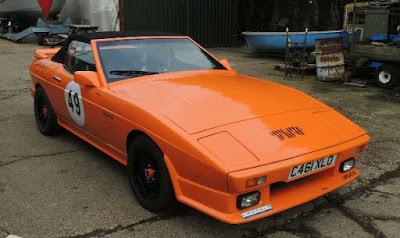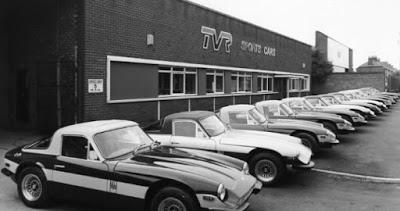
Blackpool's iconic TVR (350i Tasmin from 1980s)
Here begins a short history lesson, none of which I knew before I came to live in the jewel of the north. It's as chequered as a racing flag. Apologies to any automobile experts reading my trimmed-down resume of TVR's stop-start journey through the decades. I've kept it brief for general consumption; and for anyone not really interested in cars, I urge you to stick with it. By the way, I drive a Vauxhall Corsa! Although I enjoy driving, I find that getting from A to B reliably, comfortably (with a good sound system) and economically is good enough for me.TVR is reckoned by those who know and care to be one of the most prestigious of independent British car makers. Indeed at the height of its success it was the third largest specialist sports car manufacturer in the world - and it was based in sunny Blackpool.
Founded in the town in 1946 by local lad Trevor Wilkinson, Trevcar Motors gradually evolved into TVR Engineering and by the early 1950s was producing its first 'kit car', the TVR sports saloon for DIY enthusiasts. It retailed at £650. TVR sports cars began to gain a reputation on the racing circuit and in 1955 new investors made possible the acquisition of larger premises in Layton, Blackpool, which move coincided with interest from America and the launch of the TVR coupe.
Feedback from the American market led to changes in styling and the next venture was the Grantura, a fast-back sports car with a Coventry Climax engine and leather upholstery which was well-reviewed in Autocar magazine in 1959. The real problem for TVR was production capacity - it was only managing to complete one car per month and the order backlog was growing! With more staff (increased to 43) and a new production manager throughput improved but the changes led to the departure of TVR's founder. More attention was then paid to TVR making a name for itself on the international racing circuit but that proved a costly venture and coincided with the American importer defaulting on payments in late 1962. The workforce was laid off and TVR moved into receivership (not for the last time).
A restructuring and financing deal gave it a new lease of life for some months but by the end of 1964 the company went into liquidation. Arthur and Martin Lilley purchased the assets of TVR to mitigate their personal losses of TVR shares and a new era was born. Success would have to be achieved by bringing new marques to market and so the TVR Tuscan and Vixen were launched upon the swinging sixties, TVR's fortunes began to rise and the company moved to larger quarters in Bristol Avenue (see below) where production rose to between five and eight cars per week!

New vehicles outside the Bristol Avenue factory in Blackpool
In a publicity move that would be rightly frowned upon today, nude models were hired to disport themselves on the bonnets of TVR cars at the Earls Court Motor Show in 1970 and 1971, a ploy which drew international attention to the vehicles but nearly got TVR banned from the event.
The company continued to grow throughout the decade. Order books were full with the Vixen, Taimar and the M series proving popular in both Europe and America. The Tasmin (pictured earlier) was intended to consolidate TVR's reputation into the 1980s but its high price didn't sit well with the recession that hit the UK at the beginning of the decade and with TVR once more on the brink of financial collapse, the Lilleys sold out to wealthy Blackpool businessman and TVR customer Peter Wheeler.
Wheeler was at the helm for the next twenty years, overseeing the emergence of some of TVR's most popular models - the Griffith (2,300 built), Chimaera (5,200), Cerbera (1,490) and revamped Tuscan (1,700). He finally sold the company as a sound concern for a reputed £15 million in 2004 to Russian businessman Nikolay Smolensky. (As a footnote to the Wheeler era, when he died his wealthy widow Vicky married Karl Oyston of Blackpool FC infamy.)
There had been talk at the turn of the millennium of grand plans to move TVR to new premises (see the artist's impression below) but the reality was more sobering. Behind the scenes, Smolensky split TVR into a number of companies - smells like asset-stripping spirit? - one of which, Blackpool Automotive, held the factory and manufacturing assets. By the end of 2006 it was in administration. Half-built TVR shells lay degrading in overgrown yards. The Bristol Avenue premises has since been demolished.

The dream that never materialised
However, that's not quite the end of the story. In 2013 Smolensky sold his ownership rights to a new British company TVR Automotive. In 2016 it was announced that TVR would build a new factory in Ebbw Vale with investment from the Welsh government and a new marque of the TVR, dubbed 'God's own sports car' is set to be unveiled this year as the latest TVR Griffith, positioned as a rival to the Porsche 911. If you need to ask how much it will cost, you probably can't afford one.It's a sobering tale, for sure, an account of the decline of British manufacturing industry in miniature; and a small part of me is momentarily sad that TVR is not part of Blackpool anymore. So it goes for boys and their toys, but real livelihoods have been lost in the process.
Before you read this week's poem (a twist on the tale of the 1970 Motor Show as I strike a blow against sexploitation), I need to tell you about an American colleague of mine on assignment in London in the 1980s who wondered why people in the office smirked every time they walked past her desk. It had to be explained to her that the little book lying on top of her in-tray was the culprit: 'Everyday Fanny-Shaping Exercises'. We culturally sheltered Brits didn't realize fanny was merely American slang for the posterior (of course).
Sex Objects
I'll thank you
to shift your fanny off my bonnet.
What would your mother say?
You've got it all on display!
You're a naked distraction
to the main attraction -
which is supposed to be me,
by the way.
What's that?
It's not a competition?
All the boys love a fast car
and a curvy girl?
Get out of here
you shameless hussy!
This is about the curvy car
and not the fast girl,
so stop cavorting on my chassis,
it's just pervy.
Put some clothes on
and skidaddle will you?
Let the people see the product:
V8 engine, water-cooled,
ceramic brakes, heated seats
and leather tooling.
Watch them drool.
Thanks for reading. Keep your hands on the wheel. Happy motoring, Steve ;-) Email ThisBlogThis!Share to TwitterShare to Facebook
Reactions:
